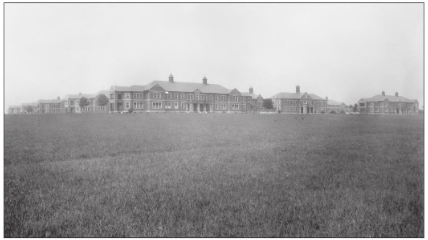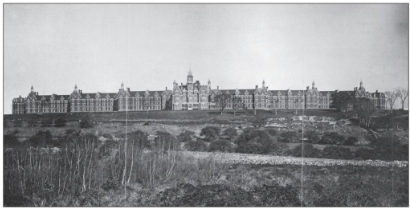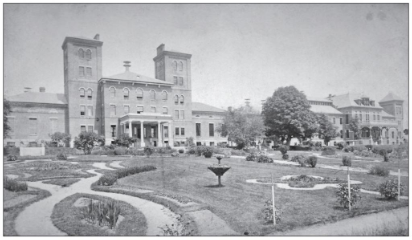At their core, state hospitals across the United States shared the same goals and challenges: to treat America’s mentally ill. They rose in popularity during the mid-to-late 1800s, and remained open through most of the 20th century. Most practiced the leading treatments of the day, including electric shock therapy, strait jackets, and lobotomies – methods later deemed inhumane. Likewise, the majority of hospitals came to an end when their funding dwindled and smaller institutions became preferable for patients. These are five state hospitals and their stories.
Byberry State Hospital

Byberry State Hospital, officially known as the Philadelphia State Hospital, bears the scars from years of inhumane conditions of its patients. The hospital opened in the early 1900s with just a handful of patients, but by 1953 had over 50 buildings, making it one of the nation’s most overcrowded institutions. It was home to both the mentally challenged and criminally insane, and both were succumbed to regular abuse and neglect.
The hospital rose to national attention through a series of investigations by local journalists and state health departments. Published photos revealed patients sleeping in the halls due to overcrowding, human waste on hall floors, and nude patients sitting unattended. Byberry was closed in the late 1980s after being declared a “clinical and management nightmare.” Today, most of the buildings have been destroyed, and built over with offices and urban housing.
Hudson River State Hospital
The Hudson River State Hospital opened in Poughkeepsie, New York, in 1871, and was still operating as recently as 2003. The hospital was founded under “Moral Treatment” – a movement that was spear-headed by mental health activist Dorothea Dix. As the name suggests, it focused on providing patients with fair and humane treatments. Hudson River was one of the largest institutions in the country, with over 160 acres of buildings to house and treat patients.
Hudson River was at the helm of the time’s newest treatment methods. Hospital employees were taught to monitor patients closely, and promote exercise and healthy eating. As the 21st century neared, new methods of treatment like medication and talk therapy grew into popularity. Unfortunately, Hudson River was forced to shut down due to insufficient funds to maintain its buildings.
Danvers State Hospital

Originally known as the State Lunatic Asylum at Danvers, the hospital welcomed its first patients in 1878. Danvers was considered a success in its earliest years: employing 125 people and treating more than 9,500 patients since opening. However, the hospital was quickly overcrowded, leading to the poor treatment of patients. Patients wandered the halls naked, lived in their own filth due to lacking basic hygiene, and many experienced a worsening of their symptoms.
Danvers is thought to be the birthplace of the prefrontal lobotomy. When shock treatments and strait jackets offered no relief to patients, doctors opted for the lobotomy surgery, which they believed to be a cure for anyone’s insanity. Poor funding made conditions even worse, and the state closed the hospital by 1992. Today, Danvers reputation as a haunted hospital makes it a favorite location for thrill-seekers looking for a supernatural scare.
Camarillo State Hospital
The Camarillo State Hospital located in Camarillo, California, operated from 1936 to 1997. During the mid-1900s, it was at the center of cutting-edge treatments for mentally ill patients, including revolutionary drug and therapy treatments for schizophrenia patients. Unlike several other hospitals functioning at the time, Camarillo State Hospital helped patients who would have formerly been resigned to an institution, including those who had undergone minor lobotomies, return to a somewhat normal life. They were one of the leaders in researching drug therapies, and housed one of the first units to help autistic patients.
Camarillo State Hospital met the same fate as many others like it during the late 1900s. Due to increased per patient costs and a lack of funding, the governor of California closed the hospital. Members of the public tried to keep the hospital open, saying they could house the criminally insane there to help increase patient numbers, but the hospital remained on its path to closure. The buildings were converted to California State University, where the first classes were held in 2002.
Westborough State Hospital

Westborough State Hospital started as a reform school for boys called the Lyman School, and could house 400 to 500 troublesome boys. However, it was found unfit for its purpose and converted to an insane asylum during the 1880s. Patients here received fairly mild treatments compared to other hospitals of the day. Bed rest and hydrotherapy were common, along with occupational therapy and relaxation drugs. By the end of World War II, the hospital sponsored more than 1,700 patients.
Problems arose when the hospital population increased dramatically in the years following the war. This led to an overcrowding that hospital staff struggled to keep up with. As technology and knowledge around the treatment of mentally ill patients improved, Westborough’s population dwindled until it finally closed in 2010.
These five hospitals were among the most prominent institutions during the 20th century. Their stories and those of their patients are plentiful, and their role in the history of health is not to be forgotten.

